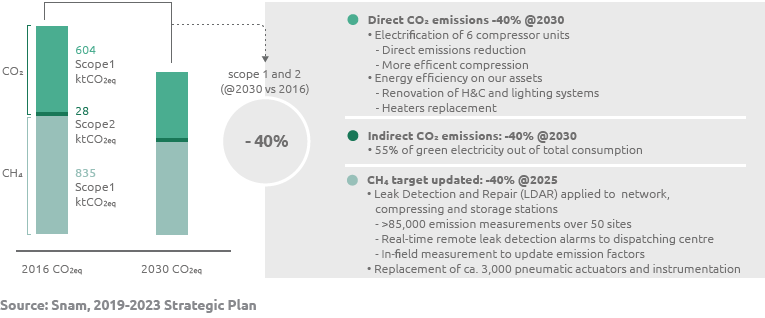The scenarios
By producing forward-looking energy scenarios, Snam presents a vision of possible developments of the Italian energy system in the medium-long-term (2030, 2040 and 2050) that takes into consideration the energy and environmental policy guidelines nationally and at an EU level. Specifically, these scenarios are consistent with the national renewable energy, emissions reduction and energy efficiency targets to 2030 in the Integrated National Plan for Energy and Climate (PNIEC).
Snam scenarios

PNIEC: Integrated National Plan for Energy and Climate
BAU: Business-as-usual scenario
CEN: Centralized scenario
DEC: Decentralized scenario
In order to develop a business strategy that is in line with the European and national decarbonisation targets and with Snam’s commitment to energy transition, the company has developed medium-long-term energy scenarios: the “Snam-Terna joint energy scenarios” to 2040, as a prerequisite for the preparation of development plans for the transmission and transportation networks, and the “Hydrogen potential” that evaluates the potential of hydrogen in Italy to 2050 produced with the analytical support of McKinsey.
Snam-Terna joint energy scenarios
Snam developed the “Document describing the 2019 scenarios” in collaboration with Terna, the operator that manages the electricity transmission networks in Italy in conformity with resolutions 654/2017/R/EEL and 689/2017/R/GAS. This study represents the result of the analyses conducted by Snam and Terma to obtain a vision that is consistent with the possible Italian energy system developments by 2040, a prerequisite for the preparation of the electricity and gas sector transmission and transportation network development plans in Italy.
Scenario – “Hydrogen Potential”
Snam presented a study into the potential of hydrogen as an energy transition vector in Italy at the “Hydrogen Challenge” event held on the 10th of October 2019 in Rome. The study analyses the potential of hydrogen in the future for the national energy system and highlights its key role in achieving the decarbonisation goals.
Time horizon of the scenarios considered by Snam
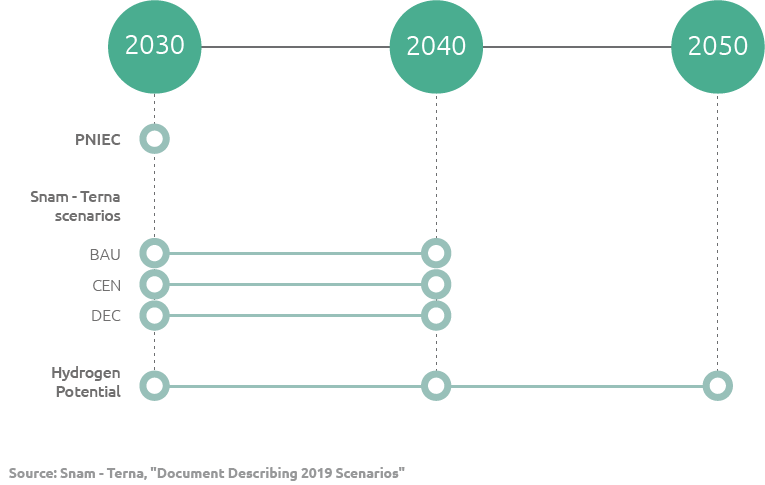
The Snam-Terna joint energy scenarios have made it possible to pool the specific expertise of the two operators, in the awareness that the interaction between scenarios in the electricity and gas sectors constitutes a new, very complex feature, both nationally and at EU level. The results collected in the Document Describing the Scenarios (DDS 2019), show how collaboration and the synergies between the electricity sector and the gas sector could be key in achieving the emission reduction targets.
Specifically, the study conducted jointly by the two operators led to the development of three different scenarios: the Business-As-Usual (BAU) scenario, the Centralized scenario (CEN), and the Decentralized scenario (DEC).
The BAU scenario features a technological mechanism for switching to more efficient technologies, guided purely by the market and a reduction in costs, and does not include reaching the European and national energy reduction targets.
The CEN and DEC development scenarios, on the other hand, represent a guide for defining a long-term business strategy aimed at decarbonisation. The two scenarios are rooted in the same macroeconomic context, with relatively sustained growth of 1.2% for the GDP per year and of the population (+2.4 million inhabitants by 2040) and significant investment in energy efficiency and technological development. Both scenarios are driven by achieving the European emission reduction targets by 2030 and move forward on a path that allow to reach the long-term CO2 containment requirements laid down in the European Commission “2050 long term strategy “. Specifically, in the CEN scenario, the policy goals are reached thanks to curbing consumption and the development of renewable energies with significant availability of programmable renewable resources, such as green gases, leveraging the existing gas infrastructures, while the DEC scenario envisages the increased development of consumption electrification associated with the distribution of the generation distributed by non-programmable renewable energy sources.
Future natural gas and green gas (biomethane, hydrogen and synthetic methane)
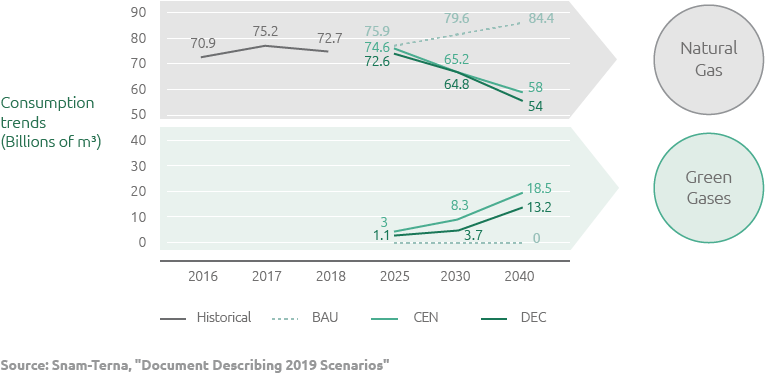
Also note that for both scenarios, the ambitious decarbonisation targets require the progressive penetration of increasing quantities of green gas in the Italian energy mix, leveraging biomethane, hydrogen and synthetic gases.
The scenarios present different gas demand trends: increasing in the BAU scenario compared with current demand – 73 billion m3 in 2018 – stable in the CEN scenario and decreasing in the PNIEC and the DEC scenarios. Both the DEC and CEN scenarios involve the European decarbonisation targets using increasingly more green gases in the Italian energy mix, relying on hydrogen, biomethane and synthetic methane.
Specifically, it is estimated that in 2030 the demand for green gas will be 8.3 bcm in the CEN scenario and 3.7 bcm in the DEC scenario. By 2040 there is expected to be further growth in the demand for green gas, equal to 18.5 bcm in the CEN scenario and 13.2 bcm in the DEC scenario. Green gases will partly replace natural gas, not only in thermoelectric power plants, but also with end users: civil, industrial and transportation.
To achieve the “zero emissions” target by 2050, in the context of economic growth of 1% of the GDP to 2050, Italy should make reductions equal to 420 Mt of CO2 equivalent (-95% compared with now).
Analysis of the development of CO2eq emissions to 2050 in Italy
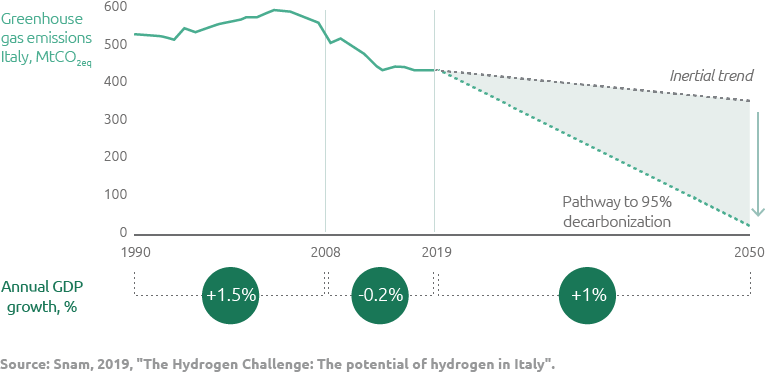
“The Hydrogen Potential” study carried out with the analytical support of McKinsey, highlights how the difficulty of reducing emissions by 95% compared with 1990 is mainly due to the presence of so-called hard-to-abate sectors that cannot be totally decarbonised through the use of non-programmable electrical renewables, and which are currently responsible for 45% of domestic emissions. Hydrogen can be used in many of these sectors, for example as a fuel for heavy goods vehicles, for heating buildings or as feedstock for several industrial processes (e.g. steelworks, ammonia production). It can also offer flexibility services to the electrical system, through solutions such as Power to Gas that allows excess electricity to be converted into hydrogen, which is easier to store and transport, also exploiting some of the existing infrastructures.
The “Hydrogen Potential” scenario estimates that by 2050 hydrogen could satisfy the 23% of the total energy demand for end users in Italy. According to this study, hydrogen would be increasingly more competitive compared with fossil fuels and other decarbonisation alternatives, especially in certain sectors such as, for example, transportation, heating and high-temperature industrial processes.
Development of the demand for hydrogen in Italy to 2050 in different sectors
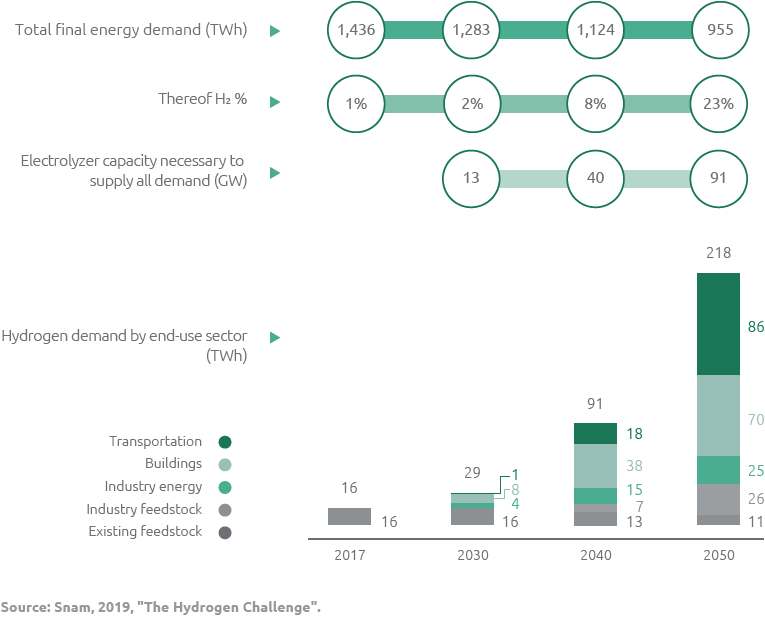
Global commitment in the fight against climate change
The strong correlation between human activity and global warming is increasingly visible and confirmed in the latest report of the Intergovernmental Panel on Climate Change (IPCC), which highlights an increase in current average global temperatures of around 1°C compared with pre-industrial levels, and 1.5°C between 2030 and 2052. The trend is obvious if you consider that, on analysing the average temperatures recorded from the 80s until now, every decade has been warmer than the previous one and the last ten years have been by far the hottest in history. The rise in temperatures will continue for centuries, causing complex changes in the climate system, such as the rise in sea levels, extreme phenomena, droughts, heavy rainfall, with risks and impact levels that differ according to the geographical location, vulnerability, levels of development and adaptation policies, resilience and mitigation of individual countries.
This is the cry of alarm that the international community launched at the UN conference on climate change, known as COP25, inaugurated in Madrid on 2 December 2019. In anticipation of the crucial 2020 deadlines established in the Paris Agreement, the leaders focused global attention on the climate emergency and the urgent need to significantly extend arrangements to achieve the three main climate goals: reduce emissions by 45% by 2030; achieve climate neutrality by 2050 and stabilise the increase in global warming to within 1.5° C.
The data and estimates of the World Meteorological Organization (WMO), highlight the difficulties in achieving these international targets. In 2018 global atmospheric concentrations of greater greenhouse gases (carbon dioxide, methane and nitrogen oxide) reached record levels. Specifically, CO2 reached 407.8±0.1 parts per million, an amount equal to 147% compared with pre-industrial levels.
In order to reach the emission reduction targets outlined in the Paris Agreement and suggested by organisations that are experts on these issues, such as the IPCC and the IEA, the European Union defined and expressed its commitment within the framework of the Clean energy for all Europeans Package by 2030 and the EU 2050 Climate Long-term Strategy, which aim not only to reduce CO2 emissions (-40% by 2030 and -100% by 2050), but also increase the share of energy produced from renewable sources (+32% by 2030) and improve energy efficiency (+32.5% by 2030).
The greater ambition in the area of energy and climate was widely accepted by the new EU Commission, which took office on 1 December 2019, in its European Green Deal (a document of a non-legislative nature). The EU Green Deal summarises the collection of initiatives that the new EU Commission intends to adopt during its term in office in order to set out on the journey to climate neutrality by 2050.
Following the direction taken by the European Union, the Italian government, like all EU countries, expressed its commitment to curb global warming. The new “Proposed Integrated National Plan for Energy and the Climate” (PNIEC), published at the end of 2019, aims to chart a course that makes the national energy system more competitive, secure and sustainable, operating in line with the decarbonisation targets defined at a European level.
European and Italian targets for 2030 and 2050
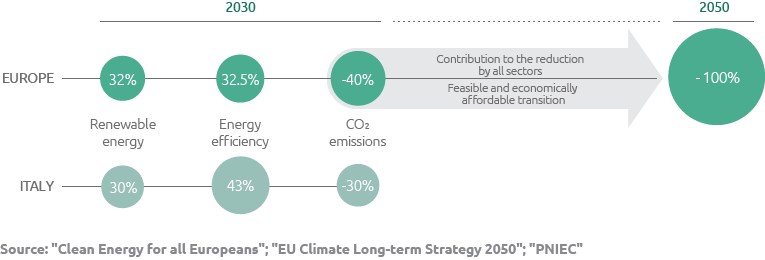
Snam’s objectives
Among the scenarios taken into consideration by Snam and the studies conducted by organisations and companies that are experts in the energy sector, green gases, such as hydrogen and biomethane, are getting ready to be the key solutions supporting the national and international energy transition, being able to contribute, through their development and use, to achieving the challenging goals of reducing emissions in the long-term.
At the end of November 2019, Snam launched the new Strategic Plan for the period 2019-2023, which traces the route that will enable the Company to tackle the challenges associated with climate change and to contribute to the reduction of emissions, minimising the increase in the global temperature and cut down energy costs for end users. Snam believes in the potential of hydrogen as a clean energy source and takes the view that injecting it into the gas networks could contribute to the development of its production from renewable sources, keeping down costs.
Snam’s sustainability activities and projects are aimed at reducing greenhouse gas emissions, in line with European and domestic decarbonisation goals.
Overall, Snam has set itself the target of reducing Scope 1 (direct) and Scope 2 (indirect) CO2 equivalent emissions by 40% by 2030 (with a base of 2016), equal to around 1.5 million tonnes of CO2 equivalent, to fight climate change in line with global objectives.
Specifically, Snam is committed to reducing its CH4 emissions by 40% by 2025 (with a base of 2016) compared with the 25% target in the previous plan. This target will be achieved through the application of a campaign for identifying and repairing methane leaks (Leak Detection and Repair), the maximum replacement of network and power plant components and the adoption of the best technologies available.
In addition, Snam is committed to a 40% reduction in direct CO2 emissions by 2030 thanks to the launch of the conversion of six gas-electric hybrid power plants which will also contribute to the flexibility of the electric system and to energy efficiency actions at buildings. To achieve the overall target of 40%, Snam also plans a 40% reduction by 2030 of CO2 generated from electricity consumption thanks to greater recourse to solar power.
Snam's objectives in the 2019-2023 Strategic Plan
